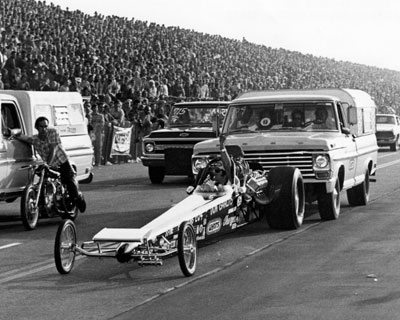THE REAR ENGINE CAR HAD ITS CRITICS; BUT MORE IMPORTANTLY IT HAD GARLITS
 The only confirmation drag racing icon Don Garlits needed to support his decision to build a new rear-engine dragster which made its national event debut at the 1971 NHRA Winternationals in Pomona, Ca., was a three inch bolt.
The only confirmation drag racing icon Don Garlits needed to support his decision to build a new rear-engine dragster which made its national event debut at the 1971 NHRA Winternationals in Pomona, Ca., was a three inch bolt.Eleven months earlier in Long Beach, Ca, Garlits had lost part of his right foot in one of drag racing’s most violent clutch explosions. The force of the explosion actually sawed the car in half.
That three inch bolt, as Garlits explained during Tuesday’s 50th anniversary Winternationals teleconference, was in his lane, ahead of his new dragster.
How A Fine-thread, Three-inch Bolt Confirmed Garlits' Intuitions ...

Eleven months earlier in Long Beach, Ca, Garlits had lost part of his right foot in one of drag racing’s most violent clutch explosions. The force of the explosion actually sawed the car in half.
That three inch bolt, as Garlits explained during Tuesday’s 50th anniversary Winternationals teleconference, was in his lane, ahead of his new dragster.
When Garlits rolled around to the Pomona starting line, he motioned for crew man Connie Swingle to come over to the car.
[There] is a three-inch bolt laying in the middle of my lane,” Garlits recalled telling Swingle. “Would you go over and get it? And Swindle said, ‘Is it a fine thread or a coarse thread?”
“I said, ‘it’s a fine thread.”
“That’s how good you could see out of those cars.”
Eleven months earlier the bolt would likely have gone unnoticed.
On that day, Garlits, who won five Winternationals in all, went on to win the race and forever change the design of Top Fuel dragsters from front-engine to rear.
Garlits' innovative new car was met with staunch criticism from the most unlikely of people. The harshest words came from the wife of a fellow Top Fuel driver.
“She walked around that car and she says, ‘I pray to God that this thing doesn’t work,” Garlits recalled. “It is the ugliest dragster I have ever seen.”
The NHRA Winternationals, in those early days, was essentially a platform for teams to show off their new wares for the season. Garlits believes that was even more cause for his skeptics to cheer for his failure.
“There were a lot of guys praying to God it wouldn’t work because they built brand-new cars,” said Garlits. “I remember one team particularly had two brand-new dragsters they were just really state-of-the-art slingshots but if this car worked, that meant those two brand-new cars weren’t going to be the cars. So it was a lot of heady feelings in the air, you know.”
Garlits was determined to save these Top Fuel racers from themselves. Up until that point, when a slingshot dragster had a fire, the hot oil and flames only had one direction to travel – back into the face of the driver. The driver was literally the paper enemy in a firing zone of engine shrapnel.
“I saw so many of my friends getting maimed and killed in those cars,” Garlits said. “And I thought, well, I’m going to try to design something here that will make it safer.”
Plus, according to Garlits, what was good for Indy car racing could be good for drag racing.
“I thought why can’t we have a dragster that goes down a quarter mile in a straight line just fine if they’re maneuvering around Indianapolis Motor Speedway at 200 miles an hour in rear engine cars,” he contended. “It didn’t make any sense to me, We couldn’t do it in drag racing yet they could go in and out of traffic 200 miles an hour with a rear engine car, and a short wheel base at that.”
Garlits won the NHRA Winternationals three times after that historic day, in what became the standard – a rear engine dragster.
Advertisement




































